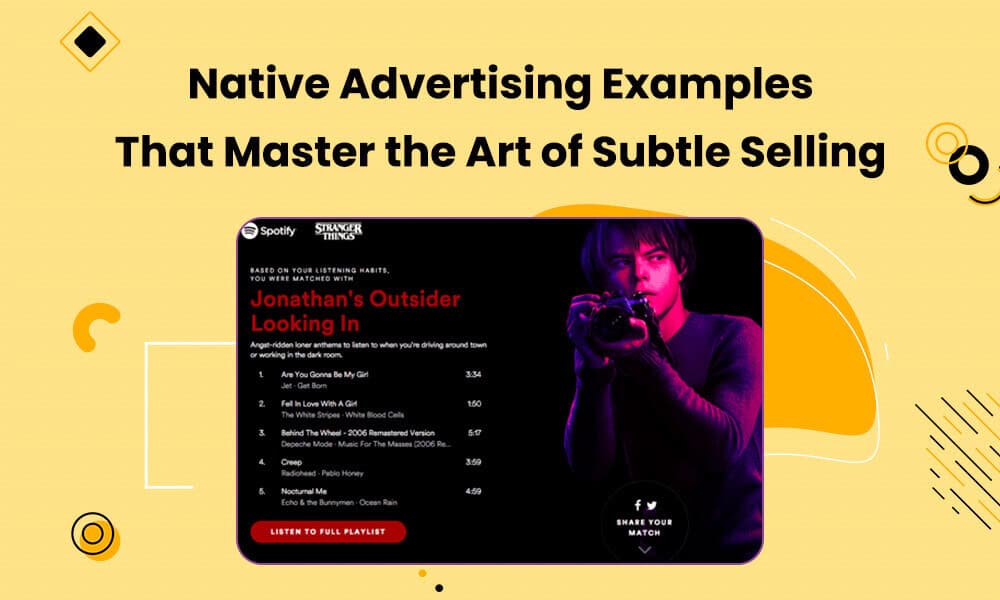We often hear you should know how to sell without selling. But what does that mean? How can you sell without allowing your ads to be visible? Well, that’s where native advertising steps in.
Native advertising brings in the art of hiding your ads in plain sight. Therefore, making you sales and money, without the users feeling like they were convinced into making those purchases.
Running native advertisements is a critical aspect of inbound marketing and paid digital marketing. Not only will they boost revenue, but will never tamper with the clear and ad-free image you’re curating for your brand.
So, in this blog, we will show you some native advertising examples, explain how exactly you can run these ads, and help you win your digital marketing game.
Are you ready? Let’s dive in!
Table of Contents
What is Native Advertising?
Native advertising is the art of hiding your offerings, services, products, or anything that generates revenue in plain sight. So much so, that the ads do not look like ads. They seamlessly fit into a platform’s interface, not causing any disruptions in the users’ engagement with the platform.
For example, all those ‘sponsored’ posts you see on your Instagram feed and stories. At first glance, you might not even think of them as ads. Their existence as native social media ads only becomes visible when you see the ‘sponsored’ tag or the Call to Action (CTA) button.

Almost all digital and social media platforms use native ads. They are the cornerstone of elevating sales and revenue both for the advertiser and the platform. Since these ads are minimally disruptive, they are more likely to build reputable brand recognition.
Why Should You Care About Running Native Ads?
Native advertising has been around for a while. In fact, the first example was seen back in the early 1900s. However, they have picked up speed since social media sites started bringing in revenue through ads.
And why not? They’re exceptionally powerful. In this section, we’ll show you how.
- Non-intrusive: Nobody likes being on a platform and being interrupted in their bliss by an ad. Native ads remove that problem, as 85% of internet users do not see native ads as distracting. They seamlessly fit into the interface, making offerings look less ‘cheapened’.
- More clicks: Sometimes, a native campaign seamlessly looks like one of the social media posts users are interested in. Therefore, users are more likely to tap and click, trickling into the sales funnel quickly.
- Targeted marketing: Native ads are paid content. They are paid ads that are displayed through intensive algorithms. Hence, it only reaches the target audience. The more relevant the ad is to someone, the more sales and ROI they achieve.
- Building trust: 75% of users trust native ads just by their subtlety. So, if you want to build trust while selling, native ads are the way to go.
- Higher engagement: Users are 25% more likely to engage with native ads than traditional ads. As we already know, the ‘social’ aspect of social media is what will push your brand further.
- Platform integrity: Maintaining integrity and goodwill are paramount for any platform–be it social media, blog, newspaper, or magazine. Displaying too many ads might dissuade users from engaging. However, native ads remove the ‘ad’ aspect from the campaign.
- Reduced ad fatigue: We’re often bombarded with ads. But, since native ads are so hidden and subtle, they remove that fatigue for users.
Read also: Bold eCommerce Advertising Strategies for Business Growth
Elements That Make a Native Ad Successful
Your in-feed ads should look extremely natural to the platform and the user experience. They’re meant to be natural.
Maybe that’s why, just like nature, the best of them are made of five elements–headline, media, content, alignment, and funnel placement.
Headline: The fire that fuels your native advertisement
Your native ad’s headline is what will define the purpose to your audience. Therefore, it will fuel them to stay further with the value it provides.
Writing a good headline is sure to lead to more conversions since it hooks the users from the beginning. Therefore, always focusing on creating relevant, informative/entertaining, and quality content allows you to reach your audience the best.
Media: The water that flows customers into engagement
Media is what flows customers to stay with your advertisements. While images are great, video content works great for story-based native advertising. The media for your ads should never be an afterthought.
It should be part of the initial brainstorming. It should play a significant role in determining how your successful native ad will flow.
Engaging, persuasive, and informative video native ads are ideal to push those sales at ease.
Content: The air that breathes life into your ad
Content marketing plays a huge role in native advertising. You need to know what content your ad will work the best with, what tone your users are looking for, and how to get action from users.
You can experiment with informative, persuasive, authoritative, and entertaining tones. Whatever suits your brand, the ad, and your audience the best.
Alignment: The earth that grounds your native campaign
You need a win-win to run a successful native ad. Not only do you want your offerings to sell you, but you also need to make sure the platform runs on optimum performance. To do that, you need to align all your native ads according to the platform in question.
For example, if you are running ads on stories on Meta and Instagram, you should create a separate ad format for LinkedIn. Aligning native ad formats with the platform’s interface is crucial for a winning performance.
Funnel Placement: The space that supercharges sales
In-feed ads do not deliberately sell to users. Therefore, you must be careful about placing them in the sales funnel. Consider the space the ad is going to go in and mold the media and content by how aware the viewers are of your offerings.
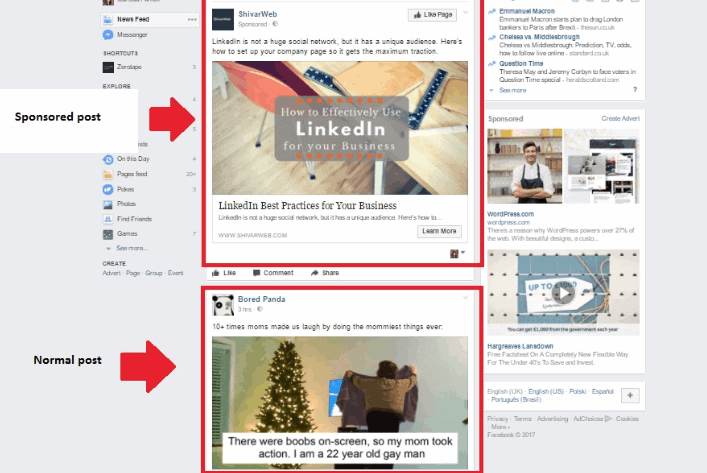
Glorious Native Advertising Examples To Derive Inspiration From
The best native advertising examples lead to the topmost inspiration. Therefore, we have here curated a list wherein each native ad example will help you get a good idea of what they are, to begin with, and how to create one for yourself as well.
Google does native digital advertising the best
While this is not one of the native advertising examples, it is a form that can never go unnoticed. No matter what you search on Google, you will always see a list of ads before the organic content starts getting listed.
The only way to distinguish between the organic content and the paid content is the small ‘ad’ mentioned on the side. It is important to show this as an example because you should know that whenever you put it on the internet, it can be displayed like this through Google’s native advertising.

Storytelling taken to the next level by JFOODO
The Japan Food Product Overseas Promotion Center (JFOODO) took over a page from CNN for this native campaign. This page is called “From Ocean to Plate”, a great example of native advertising because it looks like just another CNN landing page.
However, in reality, it takes the readers on the journey of how the fishing and culinary experience is run by the restaurant owner, Hirotoshi Osumi.
Through each scroll, the readers see the fishing, shucking, and cooking process through video content, images, and quotes. The interaction quotient of this native ad is exemplary.
And hence, not only does it spread awareness, but the experience motivates sales as well.
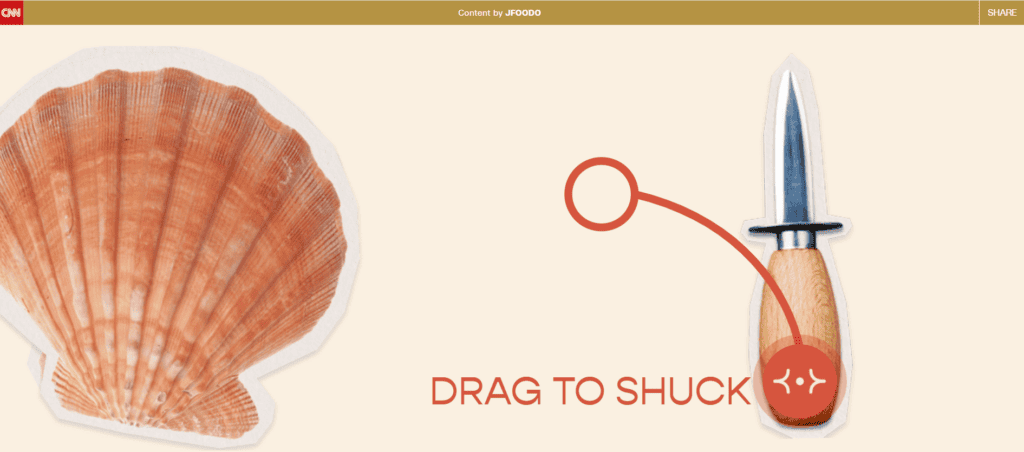
True classic Tees hit the humor perfectly
Remember how we discussed aligning your native ads to the platform? That is exactly what True Classic Tees did with this incredibly simple and effective native ad. They employed the humor expected from a platform like Instagram and from their target audience.
If the ad were to run on a platform like LinkedIn, it would surely be a miss.
The fact that if this ad were to run on a story, it would seamlessly blend into the platform wins the cake for us.

A face averaging story by BBC
Face Averaging is a technology that needs a lot of information and storytelling to be understood by the audience. So, instead of only doing a series of informative blogs and articles, LearnOpenCV partnered with BBC Future to create this page-long native ad.
Throughout the ad/blog, we see an analysis of popular and influential American politicians’ faces and what their expressions and face structure say about them. Storytelling and practical demonstration take precedence in this example.
It creates a sense of intrigue in the reader and then hits them with an irresistible CTA of trying the face-averaging platform for themselves.
What makes this a great native advertising example for us is the fact that it uses the entire blog as an ad. Therefore, it is not only a part of the user experience but becomes a whole user interaction piece within itself.

Stranger Things’ branded playlist on Spotify
Not every native ad has to be a specific creative. It can also be an offering in itself that raises awareness about a high-ticket service, offer, or revenue-generating source.
This is perfectly illustrated by the official playlists that the show-makers of Stranger Things created. They made branded playlists on the music streaming platform. These playlists are free for anybody to access and act as native ads on Spotify because they do not interrupt the user experience. And yet, they direct the audience towards the show.
Such native advertising examples end up becoming trends within an industry. Stranger Things is not the only platform doing this. Several movies and TV shows now have their own branded playlists that, while not being native ads in theory, get the same result.
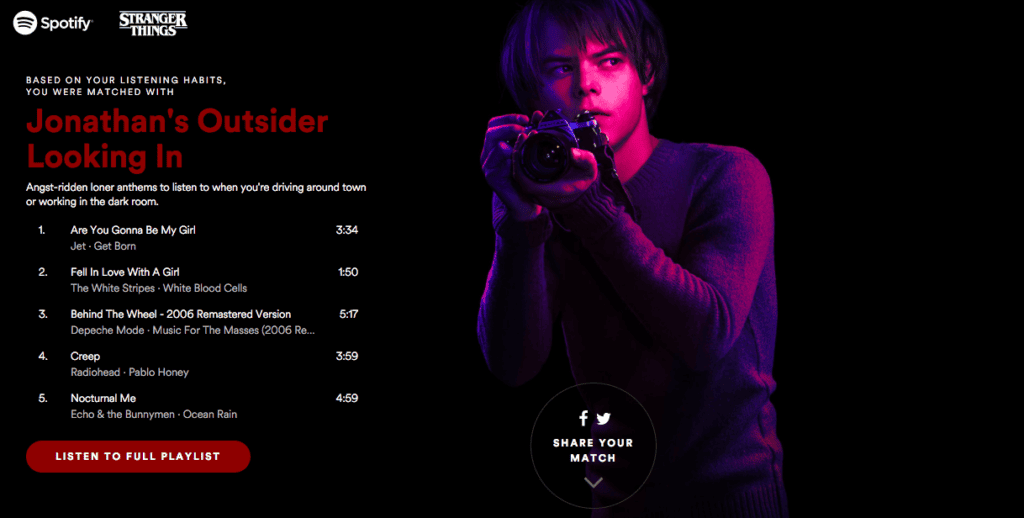
Samsung taking over the TikTok world by a storm
Samsung has always been great at its marketing game. However, they set some serious native advertising examples when they took over TikTok with their native advertising campaigns.
They used the platform and the topmost influencers to feature their latest products in their videos. With catchy music, content, and perfect product placements, each paid post led to conversions.
Mixing this native ad idea with influencer marketing was genius! And something that several brands do now.
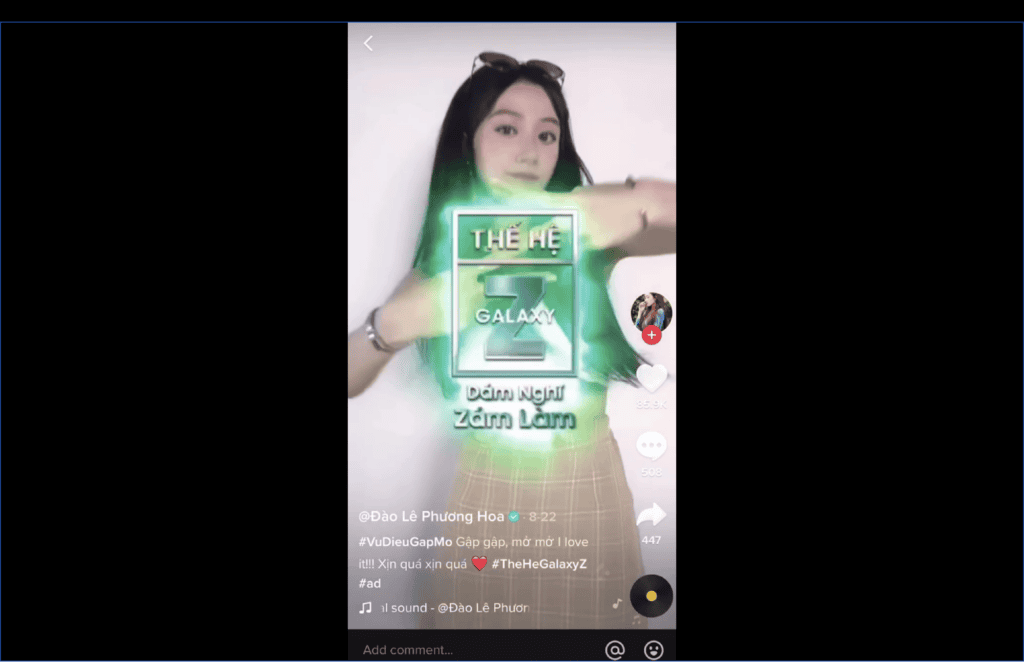
Read also: Google Ad Examples We Should All Learn From
Simple Steps to Craft Awesome Native Ads
Now that you have a good idea of what the best native ads look like, you must be itching to create your own, right? Let us help you create some in this section.
We’ll walk you through the entire process–from conceptualization to creation and deployment.
Step 1: Set a campaign goal
Building a successful campaign begins even before you’ve thought about it in fruiting stages. The first step is to set a goal you want to achieve with the native advertising efforts. Some common goals are:
- Building awareness
- Boosting traffic
- Gaining leads
- Driving sales
It is crucial to go through this step patiently to make sure that the rest of your ad campaign creation process is streamlined to what exactly you want out of the ad.
For example, if you’re only looking to increase brand awareness, you do not have to add any specific CTA to the ad. You will, instead, have to create an ad that highlights your brand’s values, identity, and offerings most appealingly.
Step 2: Define and understand your target audience
Understanding your target audience is the next important step to make, even before you start building your native advertisement. This is an important step because you will want the content to be relevant to your audience’s response, right?
Make sure you know:
- Who your target audience is
- What their pain points are
- What are their interests
- How they solve problems
- What emotions resonate the most with them
By doing this, you’ll hit them right where it hurts. Therefore, you are more likely to get more clicks and sales.
For example, if you’re running a quirky t-shirt brand, you’ll have to mold the ads according to the kind of people who will wear your products. They are more likely students, quirky, like anime, etc.
So, if your ads talk deeply about the t-shirt-making process, it won’t hit. However, speaking about the story behind an anime-centric design will hit the mark for sure.
Step 3: Choose where to publish the native advertising campaign
As part of your marketing strategy, you will have to select which platforms you want to leverage for your native advertising efforts. After all, no two platforms are the same. To explore options beyond the major players, you can check Taboola and other native ad platforms. They all have different audience personas, audience size, purpose, and content consumption styles.
So, if you’re looking to spread awareness, platforms like BBC will work best. They have a huge readership and provide a good space for you to be creative with the story you tell about your brand or offerings.
On the other hand, for small-ticket sales, platforms like Meta, X (formerly Twitter), TikTok, and Instagram work best. LinkedIn might work great for high-ticket and business-centric offerings.
You should also consider the media formats that work best on each platform. If you are great with static image content, Meta and X (formerly Twitter) might be your best suit.
However, if your strong suit is video, you should try your hands at YouTube, TikTok, and Instagram.

Step 4: Create gripping media and content
Now comes the step that excites most people–creating the content. Here are some steps that need to take place:
- Study your competitors’ content. This will give you an idea of what kind of content is working and where you can improve and fill your audience’s consumption gaps.
- Brainstorm on content form. You will need to study your resources and market requirements for this. See what will work best for you – static graphics or video.
- Strategize your content. Before the writing and designing begin, you need to plan out what exactly you want your content to look like. What do you want to show and convey to your audience? Only with this in mind will creation become simpler.
- Start creating. Now is the time to use your or someone else’s copywriting and design skills. Create impactful content in a tone that matches your audiences, and create graphics that will grip them while being true to your brand identity.
Step 5: Define your native ad spending
Define the cost per click (CPC) that works best for your brand. Define your spending limit so that you can get the best ROI through your efforts.
Once this is done, you can set the platform’s limit, and voila! You’re all set to publish your ad! A budget of between $50 and $100 a day is generally good.
However, we recommend taking it slow and starting with as little as $30 per day for your native ad. You can then see how the ad is working and adjust your spending accordingly.
Step 6: Deploy, track, and optimize
Once your ad is out there, it’s time for you to perform A/B testing. You need to check how your audience is interacting with your content. See what can be improved by making small changes throughout the first few hours of the campaign going live.
Native advertising, or any form of advertising in general, is an ongoing process of learning and unlearning. You need to keep deploying, changing, tracking, analyzing, and improving your ads over time.
Read more: Top Local Advertising Ideas to Elevate Your Marketing
Best Practices in Native Advertising
To best your digital advertising game, you should master the following tricks and practices surrounding native advertising.
- Deploy for your audience: Sometimes, it’s easy to get carried away by other factors, but it is crucial to only make ads for your target audience. After all, they’re the ones spending the monkey on you.
- Align on all angles: Angle your content for your audience while aligning the content to your marketing goals, platform requirements, brand values, and offerings. Alignment on all angles is crucial.
- Pay close attention to content creation: Quality content will make or break your native advertisements. Ensure the content is targeted and practical, the graphics are sharp, and the overall vibe of the ad is yielding!
- Limit spending: To maximize the benefits of native advertising, you need to limit your spending.
Read also: 10 Ad Copy Examples That Are So Good, It Hurts!
Conclusion
Before you dive into the world of native advertising, you must always learn what it is about and how to do it best. You must also study the best native advertising examples to get an idea of all your options and how to build a campaign that is as unique as your business.
As we conclude this blog, we’ll remind you of the key takeaway from this topic—alignment is king. Your native ads should be aligned with your audience, offerings, brand, publishing platform, and marketing goals.
Happy advertising!
Frequently Asked Questions
What is native advertising, and how does it work?
Native advertising is a form of paid media and paid advertisement in which the ads look, feel, and function exactly like the platform on which they’re displayed. Their motive is not to disrupt the user’s interaction with the platform.
They work as you pay on the platform and set audience intentions. The platform then displays ads according to its natural interface and pre-defined filters.
How can I ensure my native ads don’t disrupt the user experience?
For your native ads to not disrupt the user experience, you must ensure that the format and design match the platform’s. This way, the user will not distinguish between organic and paid content.
You should also ensure that your content is relevant to the platform so as not to take the user by surprise.
Are native ads more effective than traditional ads?
Yes, native ads are more effective than traditional ads because they are subtle. They do not look like ads and, hence, command more trust from the audience. They also lead to more clicks, so the users are already deeply engrossed in their social media activities.
How do I measure the success of my native advertising campaign?
First, you need to define the goals for your native ad. You can then measure improvements in those sectors. For example, if your goal from the native ad is to get website traffic, you should check how much traffic your website has seen during the run of the native ad.
Can native advertising fit into a small business’s limited marketing budget?
Yes, since native ads are generally higher-yielding, they require less budget. Therefore, as long as you create gripping and converting content, they can fit into a small business’ limited marketing budget.
How do I choose the right platform for my native ads?
To choose the right platform for your native ads, you should consider factors such as:
- Business objectives
- Platform’s audience size and nature
- Pricing models
- Ad formats and placement
- Analytics tools
- Reporting capabilities
What are the common pitfalls in native advertising, and how can I avoid them?
Some of the common pitfalls of native advertising are as follows.
- Lack of transparency: Always add a ‘paid sponsorship’ tag on the posts so your audience doesn’t feel misled and misinformed.
- Low relevance: There is no point in displaying ads that are not relevant to your audience. You need to do your research well in advance and craft posts according to your audience’s taste.
- Placement issues: Native ads sometimes do not fit the platform right and look out of place. To avoid this, you need to create separate content for separate placements.
How can I make my native ads stand out in a crowded content landscape?
Some things that will make your native stand out:
- Well-researched content tailored to your audience’s needs
- Storytelling
- Great quality graphics and media
What’s the future of native advertising in digital marketing?
The future of native advertising is very secure in the realm of digital marketing. Native advertising, in the coming years, will center around authentic connections, storytelling, and the seamless integration of brand messages into immersive experiences across various digital landscapes.
Native ads can also be integrated into virtual reality as the space expands further.
How frequently should I refresh my native ad content?
Your native ad should have the same content for at least 60 seconds. For A/B testing, you can refresh the content every 2 minutes. It is also advisable to run new ads every month.
